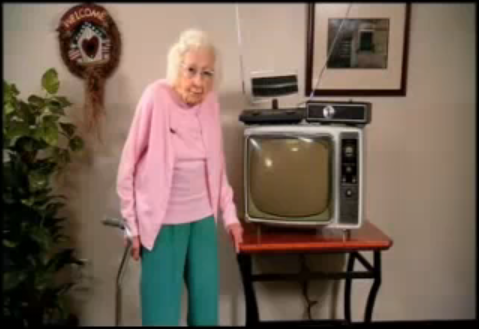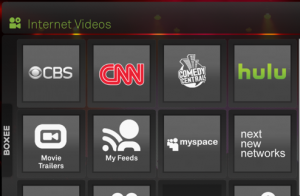In honor of today’s shut-off of analog over-the-air TV, we’re posting a link to this humorous video showing the difficulties of the digital transition.
Analog Over-The-Air TV Ends Tomorrow Night
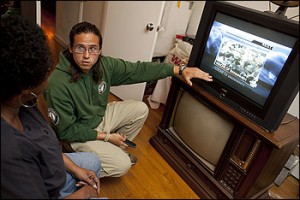 The over-the-air free TV that is available with an antenna has been available in both digital and analog formats during the transition to digital TV. Midnight tomorrow night, June 12th, the analog signal will be shut off.
The over-the-air free TV that is available with an antenna has been available in both digital and analog formats during the transition to digital TV. Midnight tomorrow night, June 12th, the analog signal will be shut off.
At Tech DC we have been helping a few customers, especially those who have extra TVs or who live in rural areas not served by cable, to switch to Digital TV. See Tech DC’s 7 Misconceptions about Over-the-air Digital TV. And remember that if you do get TV through analog over-the-air transmissions, then you can request $40 coupons toward a digital converter box.
From The Washington Post:
Almost 3 million U.S. homes — 60,000 households in the Washington area alone — could wake up Saturday to a blank TV screen.
By midnight tomorrow, all of the nation’s full-powered TV stations will shut off the analog signals that brought the iconic shows “I Love Lucy” and the “Cosby Show” to millions of living rooms, marking the biggest change in television viewing since the advent of Technicolor. In their place, broadcasters will air a new breed of digital broadcasts intended to bring crisper pictures and sound to shows like “American Idol.”
At the end of this long-awaited and troubled transition, the government will have made $20 billion from the sale of the old
analog airwaves, the telecommunications industry will be able to offer brand-new, high-speed wireless services, and public-safety officials will get access to airwaves for a new nationwide communications network.
But people have been left to deal with some unsatisfactory results of the poorly managed, government-mandated transition. The education campaign was uncoordinated, a federal program to help people pay for converter boxes ran out of money, and many were not informed that they might need additional equipment to receive TV service.
Those most at risk of losing programming — seniors, non-English speakers, low-income viewers and rural residents — are among the more than 14 million households that rely heavily on over-the-air signals to receive critical public-safety alerts, news and weather reports.
“The problems for those people will be much greater than the forecast,” John Carey, a professor of communications and media management at Fordham University.
Older analog sets that rely on rabbit-ear antennas will need a converter box, which costs $50 to $80. TV sets with digital tuners will receive broadcasts, but viewers will need to adjust antennas and in some cases install more powerful ones.
For Maria Rubio, 67, of Langley Park, the TV has been a constant companion since her husband died two years ago. She watches five to six hours of television a day with the dial fixed on Spanish-language talk shows and telenovelas on Univision. She does not speak much English.
Rubio is worried that her pastime may disappear come Saturday. A neighbor’s teenage son hooked up a converter box, which she bought with a government-sponsored coupon for a $40 discount, to her 16-year-old TV. But she may also need a new, stronger antenna for reception.
That’s because digital signals do not travel as far or hold up to interference as well as analog. Analog signals will show a snowy picture for viewers on the edge of a station’s coverage area. But with digital signals, even the smallest obstruction — a tall tree in the yard or an airplane flying overhead — can cause the picture to freeze and sometimes disappear altogether.
Rubio said she cannot afford to buy a new antenna. “We almost could not pay for that [converter] box,” she said.
Much of the government’s education campaign focused on just getting consumers to buy converters boxes. Critics say officials waited too long to tell viewers that they will likely need a new antenna and will have to scan frequently for channels.
More than one-third of the callers to the Federal Communications Commission’s DTV call centers have cited reception problems.
The twice-delayed transition to all-digital television has been in the works for more than two decades and, when all is said and done, will have cost nearly $4 billion.
Congress had mandated that all full-power stations convert to digital signals in 2006. But the switch was pushed back to Feb. 17 because of consumer confusion and lack of equipment.
Two weeks before that deadline, Congress voted to again postpone the switch, this time to June 12, after a $1.5 billion program ran short of funds to distribute $40-off coupons to offset the cost of converter boxes. Ultimately $650 million in stimulus funds was allocated to the preparation efforts.
Nearly 800 stations, mostly in smaller markets, went ahead with the transition in February, and six more will make the change by today. That leaves 974 stations in major cities to make the switch tomorrow. Stations will be shutting off analog signals throughout the day tomorrow. In the Washington area, the CBS and ABC affiliates plan to do so in the morning, while the rest plan to make the switch between noon and midnight.
Broadcasters hope the new digital programs and improved channel offerings will lure back some viewers who subscribe to cable and satellite services. Less than 15 percent of U.S. viewers rely on free over-the-air television.
But analysts say the digital transition has instead prompted a number of people to switch to a pay-TV service to avoid the hassles of upgrading TV sets.
About 5 percent of U.S. households have subscribed to a cable or satellite service in the past year, according to a survey conducted by research firm Knowledge Networks. Jeffrey Wlodarczak, managing director of Hudson Square Research in New York, estimates that the pay-TV industry will gain nearly a half million customers in the switch.
For example, Time Warner Cable, the nation’s second-largest cable company, said it added 80,000 over-the-air customers in the first three months of the year. Satellite provider DirecTV said it signed up 50,000 to 100,000 over-the-air viewers.
“It has clearly offset the losses for companies that were already under economic pressure,” Wlodarczak said.
Sales of digital TV sets have tripled in three years, and people are expected to buy a record 34.5 million sets this year, according to the Consumer Electronics Association.
A growing number of households, however, are not watching TV the way they used to. Many now access programming through Internet-based platforms such as Hulu.com, which hosts a large catalog of new and classic shows.
Ben and Katie Hallen of the District use a Roku digital video player to stream movies and TV shows from Netflix, iTunes and Amazon.com.
“Cable was optional for us, but Internet was not,” said Ben Hallen, 30, an assistant professor at the University of Maryland. “This way we can watch things on our own schedule. I don’t feel like we’re missing out on anything.”
But about 30 percent of U.S. households are not online, and 80 percent of the nearly 14 million homes that rely on over-the-air broadcasts have never logged onto the Internet, Carey said.
Despite the inconveniences, economic experts say repurposing the old analog airwaves for wireless broadband services and communications networks for emergency responders is the most prudent use of resources.
Wireless companies have spent $20 billion for the rights to those airwaves, and federal officials hope it will help expand the reach of high-speed Internet to all corners of the country.
7 Misconceptions about Over-the-Air Digital TV
As I help people with home theaters and TVs across the Washington D.C. area, I run into many misconceptions about over-the-air digital TV.
1. Digital TV? What is that?
Most people still don’t seem to realize that they can receive high definition television over the air.
Not only is it high definition, but over-the-air (OTA) broadcasts also generally provide better quality video than cable or satellite. This is because the bitrate (amount of data transmitted) of OTA broadcasts is typically higher.
While not all the channels are available (no CNN, Comedy Central, Discovery, Home & Garden, etc), you do get in Washington D.C. and generally: ABC, NBC, CBS, PBS, Fox, CW (formerly WB), Univision (Spanish language), and an independent channel or two.
2. The digital transition, whenever it occurs, will be a switch from analog to digital.
Not exactly. The digital channels are all available now. The “digital transition” date is actually just switching off the analog channels. The analog spectrum was sold a year ago by the US government sold to a consortium of bidders including AT&T and Verizon.
3. The analog shut-off date is when?
It was originally today, February 17, 2009. But Congress and Obama passed legislation to delay it until June 12, 2009, because many people are still unprepared for the transition and the government ran out of coupons for people to buy converter boxes.
The complicated bit is that because of costs associated with running the analog systems, hundreds of local stations will still try to shut down their analog signals today, if they can get the FCC to go along with that. In Washington D.C., all stations will continue to offer analog channels until June 12th.
According to the Associated Press:
A patchwork of 641 stations across the country, mainly in thinly populated areas, are still turning off their analog broadcasts this week or have already done so. The most populous markets where many or all major-network stations are cutting analog include San Diego and Santa Barbara, Calif.; Providence, R.I.; La Crosse and Madison, Wis.; Rockford, Ill.; Sioux City, Iowa; Waco, Texas; Macon, Ga.; Scranton, Pa.; and Burlington, Vt.
4. I need a coupon and converter box.
 TVs sold over the past few years typically have a built-in digital tuner. Also, the $40 coupon is only good for the converter boxes that output their signal in analog.
TVs sold over the past few years typically have a built-in digital tuner. Also, the $40 coupon is only good for the converter boxes that output their signal in analog.
This means that if you have a shiny new HDTV, you are probably fine because it has a tuner already. And if you have a slightly older HDTV that does not have a tuner, you will be better served with a converter box that has an HDMI or component video out so that you get a digital signal to the TV itself instead of analog. And those better converter boxes do not qualify for the $40 coupon.
5. I just need to plug my antenna into a converter box to get a signal.
You will need an antenna and just plugging in your existing one might work. But the antenna is probably best not placed where you used to have it.
Digital signals tend to be more sensitive to placement and interference from walls and obstructions. Therefore you want the antenna to be as close to possible to line-of-site to the tower as you can get it. This means placing the antenna in a window, on a roof, or high up in your attic. People who live close to the transmitting towers (within 5 miles) should not have problems. People farther away will need to spend more time and money to get the right equipment.
6. My “rabbit ear” antenna will work fine.
It might if you live within a couple of miles of the antenna. But most people will be better served with a new antenna and spending some time placing it correctly in the best location.
My favorite resource for determining antenna needs is antennaweb.org, which has a Choose an antenna area. This will allow you to see how far your towers are from you and the direction of the towers. Direction is important because most HDTV antennas are directional.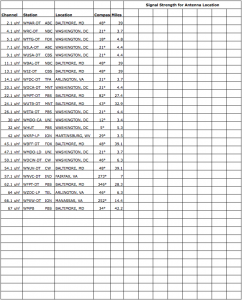
For my installations, I generally start with antennaweb.org’s data and then paste it into a spreadsheet like this. Then I can write down the signal strength for each channel using different antennas and locations. It usually takes a while to get the optimum setup.
Also note that in the D.C. area, most digital channels are on the UHF spectrum, but after the analog shut-off both ABC and CBS will be changing to transmit over VHF. The implication for customers is that several antennas only work well for UHF or VHF. Keep that in mind when looking for an antenna. Many stations across the US plan on changing their transmissions after they shut down their analog stations. Antennaweb.org lists these planned changes.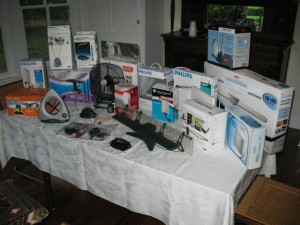
AVS Forum has a vibrant discussion of what antennas are best. I agree with their list and have had great luck both with the Winegard SS-3000 and Terk HDTVa
. Both of these have amplification which you may or may not want to use depending on how it affects your signal.
7. I can’t watch over-the-air television. I’d miss my TiVo or Cable DVR too much.
The TiVo Series 3 and TiVo HD do actually tune and record OTA broadcasts. Not only that, but they can record both OTA and cable signals at the same time. So you could get basic cable for a few channels that you are missing, and get pristine high definition content over the air. TiVo does have a monthly service fee (also available as a lifetime purchase for the life of the box).
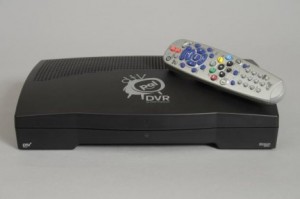 For those who want to get rid of all monthly bills and just have an OTA DVR, the satellite folks at Dish network came out with the DTVPal DVR currently for $249. You don’t use the Dish network at all. They simply took the software in their good (not as good as TiVo) DVR and repurposed it. There is a discussion of the DTVPal DVR at AVS Forum, which they jokingly refer to as the reboot/upgrade club because of the problems that the early adopters are facing. Currently the DTVPal DVR is out of stock. I would expect Dish to iron out the issues and make this a solid box, as their satellite DVR is pretty good.
For those who want to get rid of all monthly bills and just have an OTA DVR, the satellite folks at Dish network came out with the DTVPal DVR currently for $249. You don’t use the Dish network at all. They simply took the software in their good (not as good as TiVo) DVR and repurposed it. There is a discussion of the DTVPal DVR at AVS Forum, which they jokingly refer to as the reboot/upgrade club because of the problems that the early adopters are facing. Currently the DTVPal DVR is out of stock. I would expect Dish to iron out the issues and make this a solid box, as their satellite DVR is pretty good.
Cut the Cable or Satellite Bill
While the hurdles may seem daunting, the ability to get great content in high definition over the air is great. With some time and research, you might even be able to ditch your cable or satellite.
Another option that complements OTA programs is Internet based TV. Projects like Boxee are promising. They connect to CNN, Comedy Central, and tonnes of other streaming media. While the quality is not HD, this provides another way to cut the cable or satellite bill.

